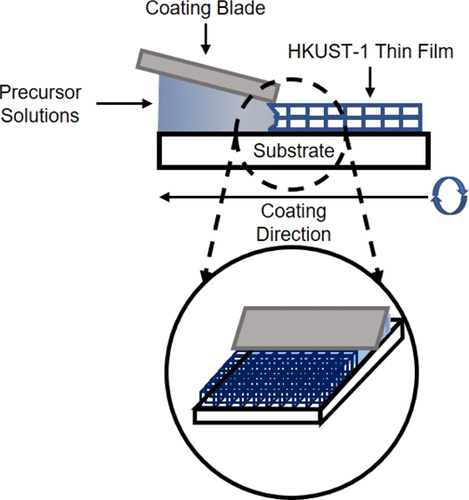当前位置:
X-MOL 学术
›
ACS Appl. Mater. Interfaces
›
论文详情
Our official English website, www.x-mol.net, welcomes your
feedback! (Note: you will need to create a separate account there.)
Conductive, Large-Area, and Continuous 7,7,8,8-Tetracyanoquinodimethane@HKUST-1 Thin Films Fabricated Using Solution Shearing
ACS Applied Materials & Interfaces ( IF 8.3 ) Pub Date : 2021-02-19 , DOI: 10.1021/acsami.1c00640 Sangeun Jung 1 , Luke Huelsenbeck 1 , Qikun Hu 2 , Sean Robinson 1 , Gaurav Giri 1
ACS Applied Materials & Interfaces ( IF 8.3 ) Pub Date : 2021-02-19 , DOI: 10.1021/acsami.1c00640 Sangeun Jung 1 , Luke Huelsenbeck 1 , Qikun Hu 2 , Sean Robinson 1 , Gaurav Giri 1
Affiliation

|
Most metal–organic frameworks (MOFs) have an insulating nature due to their porosity and redox-inactive organic components. The electrical conductivity of the prototypical MOF, HKUST-1, can be tuned by infiltrating a small-molecule organic semiconductor, 7,7,8,8-tetracyanoquinodimethane (TCNQ), into the HKUST-1 pores, creating TCNQ@HKUST-1. However, current processes of creating TCNQ@HKUST-1 films have many roadblocks such as slow crystallization rates, which limit high throughput production, and the formation of Cu(TCNQ) as a byproduct, which affects the electrical conductivity and degrades the chemical structure of HKUST-1. In this work, we show that HKUST-1 films can be rapidly synthesized over large areas with consistent thickness and no pinholes via a meniscus-guided coating technique called solution shearing. The subsequent pore activation process and TCNQ impregnation can be completed via solvent exchange to minimize the formation of the Cu(TCNQ) byproduct, and we obtain an increase in electrical conductivity of the solution-sheared TCNQ@HKUST-1 thin films of over 7 orders of magnitude, reaching a maximum value of 2.42 × 10–2 S m–1 when TCNQ is incorporated for 10 days. The conductivity of solution-sheared TCNQ@HKUST-1 is higher compared to films formed by high-pressure pelletization of TCNQ@HKUST-1. We show that solution shearing can produce large-area thin films rapidly and reduce the formation of grain boundaries better than pelletization, allowing for large-area electronics with both charge transport and porosity for applications as sensors and electronics.
中文翻译:

用溶液剪切法制备导电,大面积和连续的7,7,8,8-四氯噻吩基甲烷@ HKUST-1薄膜
大多数金属有机框架(MOF)具有多孔性和氧化还原惰性有机成分,因此具有绝缘性。可以通过向HKUST-1孔中渗透小分子有机半导体7,7,8,8-四氰基喹二甲烷(TCNQ)来调整原型MOF HKUST-1的电导率。 。但是,目前制造TCNQ @ HKUST-1薄膜的过程存在许多障碍,例如缓慢的结晶速度(这会限制高产量的生产)以及作为副产物的Cu(TCNQ)的形成,这会影响电导率并降低其化学结构。科大-1。在这项工作中,我们表明HKUST-1薄膜可以通过称为溶液剪切的弯月面引导涂覆技术在大面积上以一致的厚度快速合成,并且没有针孔。当合并了TCNQ 10天时,–2 S m –1。与通过TCNQ @ HKUST-1高压造粒形成的薄膜相比,溶液剪切的TCNQ @ HKUST-1的电导率更高。我们显示,溶液剪切比造粒可以更快地产生大面积薄膜,并减少晶粒边界的形成,从而使具有电荷传输和孔隙率的大面积电子设备可用作传感器和电子设备。
更新日期:2021-03-03
中文翻译:

用溶液剪切法制备导电,大面积和连续的7,7,8,8-四氯噻吩基甲烷@ HKUST-1薄膜
大多数金属有机框架(MOF)具有多孔性和氧化还原惰性有机成分,因此具有绝缘性。可以通过向HKUST-1孔中渗透小分子有机半导体7,7,8,8-四氰基喹二甲烷(TCNQ)来调整原型MOF HKUST-1的电导率。 。但是,目前制造TCNQ @ HKUST-1薄膜的过程存在许多障碍,例如缓慢的结晶速度(这会限制高产量的生产)以及作为副产物的Cu(TCNQ)的形成,这会影响电导率并降低其化学结构。科大-1。在这项工作中,我们表明HKUST-1薄膜可以通过称为溶液剪切的弯月面引导涂覆技术在大面积上以一致的厚度快速合成,并且没有针孔。当合并了TCNQ 10天时,–2 S m –1。与通过TCNQ @ HKUST-1高压造粒形成的薄膜相比,溶液剪切的TCNQ @ HKUST-1的电导率更高。我们显示,溶液剪切比造粒可以更快地产生大面积薄膜,并减少晶粒边界的形成,从而使具有电荷传输和孔隙率的大面积电子设备可用作传感器和电子设备。


















































 京公网安备 11010802027423号
京公网安备 11010802027423号